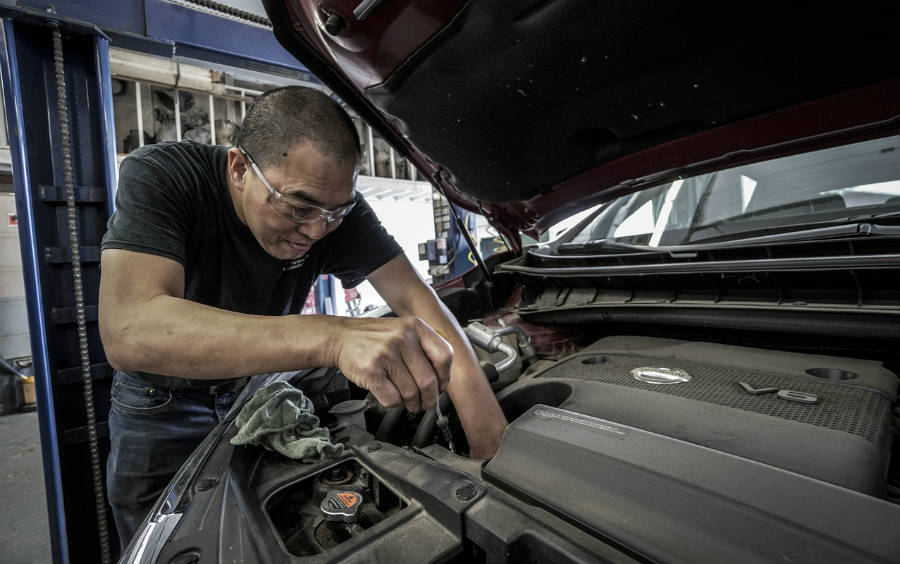As a car or truck is often a person’s largest investment, it is well worth having an inspection done on a vehicle before purchase. This is especially true if the vehicle being purchased is no longer under factory warranty.
Most dealerships and car lots will perform their own inspections, but these aren’t always thorough and a customer doesn’t usually have access to the inspection report. And the profit motive leads to some conflict of interest where the seller wants to sell a vehicle at a good price while spending as little as possible to service it.
Most dealerships, full-service chains, and independent shops are capable of doing a good used vehicle inspection. Most of the time, these are checklist-based and can have a wide variety of formats while generally checking the same things.
In spite of the variety, there are two basic levels of inspection. The first is basic safety and operations check, while the second look more thoroughly at the vehicle’s mechanical condition, especially the engine.
Cost of One-Hour Inspection
A one-hour inspection is the basic check and is similar to what most car lots and dealerships do on vehicles they take in for sale. Sometimes, it’s called a “stop/steer/go” check. This is whether a vehicle’s brakes and suspension operate as they are supposed to, and how well the engine and transmission perform.
The basic prepurchase car inspection cost is usually an hour of labor or about $100. The inspection usually starts with a test drive of 10 to 20 miles. There are many problems that don’t show up until a few miles of driving such as an overheating issue or noise or handling issues.
During a test drive, all the driver-operated controls can be checked. Also if an engine light has recently been cleared (and its cause is not repaired), often, it will take a few miles before it will reset a code.
Then, any problems are noted and the vehicle is put up on a lift to inspect the wear on the brakes and tires, look for leaks, and check the condition of the suspension. In an area prone to rust, it is most important to inspect the undercarriage, suspension members, and subframes for integrity.
Cost of a Two Hour Inspection
This may be called something else, such as a “150 point inspection”, or something along those lines. The cost to inspect used cars is usually more in the range of $200 to $250, reflecting about two hours of work.
The difference is that, in addition to all of the basic visual and driving checks, it should also involve a compression check. This is a test done by removing the spark plugs and cranking the engine over with a gauge attached.
This is to measure the pressure developed in the combustion chambers; one cylinder at a time. What the test can reveal is the wear conditions of the engine.
If all of the cylinders measure out at approximately equal compression, and if the numbers lie within the “good” range in the manufacturer’s specifications, that means that the valves and piston rings are in reasonably good shape.
If one cylinder is low, or if the numbers are generally low or show variations, that can indicate an engine with internal wear issues.
There is some debate over whether it’s worthwhile to do a compression test on an engine that seems to run ok. If a cylinder has low compression, for instance, that will usually lead to misfires and an engine warning light. No warning light means the compression is probably okay.
Having to remove the spark plugs can also lead to problems – if a plug breaks and has to be extracted, for instance. But it is possible to get an idea of an engine’s general wear condition and power-balance. Valve or ring wear problems can also show up on a compression test before they are bad enough to cause a misfire.
It’s similar to how doctors check the heartbeat during a physical exam even if the patient has no complaints or issues. They typically want to verify the most essential part first before looking beyond.
What to Expect With a Used Car Inspection
An inspection provides a checklist of items that either work or don’t work and the measurements of wear items. Most often, there are things that are wrong and things to be recommended, but estimates for repairs aren’t always provided.
In many cases, something won’t work. However, the diagnostics necessary to determine the exact problem are beyond the scope and time of inspection.
An example would be a window that doesn’t operate. It could be a window motor, a broken wire, or a bad switch. The diagnosis for that is typically an hour by itself.
Running issues would be another example. If an engine has an issue that will usually show up as a trouble code that points to a likely cause but without going through a code-specific diagnostic routine, there’s not enough certainty to write an estimate.
Rather than a firm estimate, more often, a rough idea of repair costs is given along with guidance as to the urgency of various issues and the overall condition of the vehicle. Firm estimates are usually given only on routine wear items such as brakes, tires, and struts, and so forth, if necessary.

Where to Have a Used Car Inspected
The ideal place to have a used vehicle inspected is a shop where you have your vehicle serviced regularly by an experienced and trusted mechanic. If a mechanic knows that their positive recommendation might be taken and that they will likely be servicing the vehicle, that is a motivation to be thorough and accurate.
When lacking an ideal place, another tactic is to take a vehicle to a shop run by a competitor of the seller. If it’s being purchased at a Chevrolet dealership, for instance, the vehicle might be brought to a Ford dealership for an inspection.
The automotive service business (for better or worse) tends to be very competitive, even at an individual level, and the work of another shop tends to be gone over with a fine-toothed comb whenever possible. If a dealership mechanic knows that a vehicle has gone through inspection in a competitor’s shop, and then, has the opportunity to inspect it, the odds of a thorough and detailed inspection are very high.
Regardless of where a vehicle is inspected, it’s first necessary to get the “okay” for an outside inspection to be done. It is best that a seller understand and agree to the scope of the inspection, as well as knowing where it is being done.
It is also best to schedule the work with the shop doing the work so that they can block out the time and not be rushed. Work done in a hurry is of the least value. If an inspection finds problems but the vehicle is still considered for purchase, it’s normal to give the seller the option of repairing the vehicle themselves or re-negotiating a more fair price.
Factors Affecting the Cost of the Pre-Purchase Car Inspection
As previously mentioned, the range of prices of the pre-purchase car inspection can vary depending on the package you are getting for your car. Each auto shop offers different package deals generally categorized as the standard, comprehensive and commercial inspection.
The standard inspection is the most common and does not involve too many processes. This inspection is usually done at the shop (depending on the warranty or agreement between you and the dealer) where you’re buying the car, where their mechanics will do checking of the exterior, interior, and under the hood of the vehicle, and can also include a test drive.
The comprehensive inspection includes more elaborate checks on the vehicle’s engine, frame, and a more in-depth visual observation and mechanical testing of the car’s overall performance. The mechanic conducting the inspection will be more intricate in listening to any unusual sound produced by the vehicle during the test drive as well.
Finally, commercial inspection is a type of vehicle inspection done on RVs, trucks, and other commercial vehicles. This type is much more costly than others due to the fact that commercial vehicles have more components than the standard four-wheel sedan.

